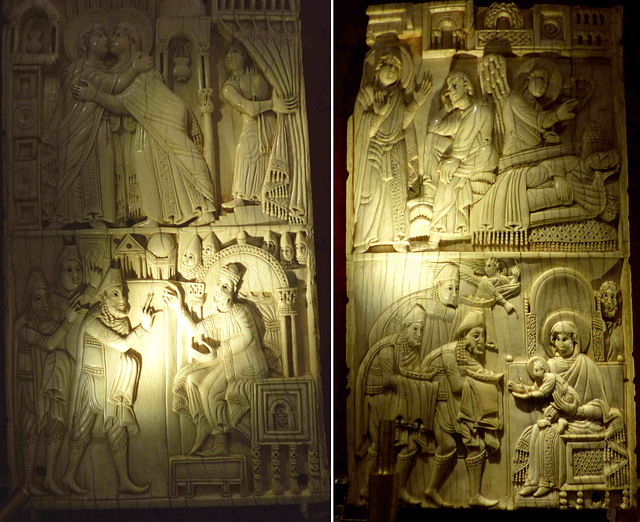Salerno - Museo Diocesano San Matteo
Salerno - Museo Diocesano San Matteo
Ravenna - Museo arcivescovile
Pisa - Museo dell'Opera del Duomo
Pisa - Museo dell'Opera del Duomo
Ravenna - Museo arcivescovile
Ravenna - Museo arcivescovile
Hildesheim - Dommuseum
Kraków - Katedra Wawelska
Tallinn - Suurgildi hoone
Auxerre - Cathédrale Saint-Étienne
Auxerre - Cathédrale Saint-Étienne
Palermo - Elephant
Tongeren - Onze-Lieve-Vrouwebasiliek
Tongeren - Onze-Lieve-Vrouwebasiliek
Cologne - Schnütgen Museum
Cologne - Schnütgen Museum
Cologne - Schnütgen Museum
Cologne - KOLUMBA
Salerno - Museo Diocesano San Matteo
Salerno - Museo Diocesano San Matteo
Salerno - Museo Diocesano San Matteo
Salerno - Museo Diocesano San Matteo
Lyon - Musée des Beaux-Arts
Quedlinburg - St. Servatius
Quedlinburg - St. Servatius
León - Palacio del Conde Luna
León - Palacio del Conde Luna
York - Minster
Pamplona - Museo de Navarra
Pamplona - Museo de Navarra
Pamplona - Museo de Navarra
Pamplona - Museo de Navarra
Pamplona - Museo de Navarra
Hannover - Landesmuseum
Hannover - Landesmuseum
Location
Lat, Lng:
You can copy the above to your favourite mapping app.
Address: unknown
You can copy the above to your favourite mapping app.
Address: unknown
See also...
Keywords
Authorizations, license
-
Visible by: Everyone -
All rights reserved
-
101 visits
Salerno - Museo Diocesano San Matteo


Salerno (pop. ~ 130.000) is located on the Gulf of Salerno on the Tyrrhenian Sea. The site has been one of the most important and strategic ports on the Mediterranean sea, yielding a rich Greco-Roman heritage. It was an independent Lombard principality in the early Middle Ages. The Normans in 1077 made Salerno the capital of their rule in all of southern Italy. In the 16th century, under the Sanseverino family, among the most powerful feudal lords in southern Italy, the city became a center of learning, culture, and the arts.
Salerno has been the seat of an archbishop since 983 and the city's medical school is famous for being the first college or "university" of medieval Europe.
The Diocesan Museum is best known for the "Salerno Ivories". A collection of ivory plaques from around the 11th or 12th century that contain elements of Early Christian, Byzantine, and Islamic art as well as influences from Western Romanesque and Anglo-Saxon art.
It is the largest unified set of ivory carvings preserved from the pre-Gothic Middle Ages and depicts narrative scenes from both the Old and New Testaments. It is supposed the ivories originated in either Salerno or Amalfi, which both contain identified ivory workshops, however, neither has been definitively linked to the plaques so the city of origin remains unknown.
The Magi visiting Herod / The Magi adorating
Salerno has been the seat of an archbishop since 983 and the city's medical school is famous for being the first college or "university" of medieval Europe.
The Diocesan Museum is best known for the "Salerno Ivories". A collection of ivory plaques from around the 11th or 12th century that contain elements of Early Christian, Byzantine, and Islamic art as well as influences from Western Romanesque and Anglo-Saxon art.
It is the largest unified set of ivory carvings preserved from the pre-Gothic Middle Ages and depicts narrative scenes from both the Old and New Testaments. It is supposed the ivories originated in either Salerno or Amalfi, which both contain identified ivory workshops, however, neither has been definitively linked to the plaques so the city of origin remains unknown.
The Magi visiting Herod / The Magi adorating
Nouchetdu38 has particularly liked this photo
- Keyboard shortcuts:
Jump to top
RSS feed- Latest comments - Subscribe to the comment feeds of this photo
- ipernity © 2007-2025
- Help & Contact
|
Club news
|
About ipernity
|
History |
ipernity Club & Prices |
Guide of good conduct
Donate | Group guidelines | Privacy policy | Terms of use | Statutes | In memoria -
Facebook
X

Sign-in to write a comment.